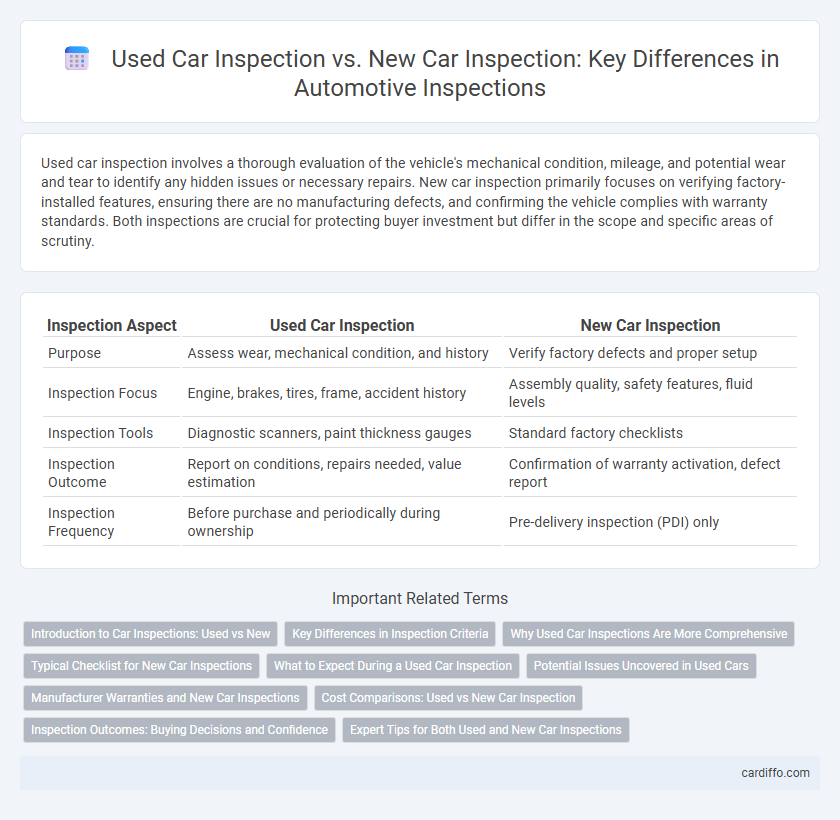Used car inspection involves a thorough evaluation of the vehicle's mechanical condition, mileage, and potential wear and tear to identify any hidden issues or necessary repairs. New car inspection primarily focuses on verifying factory-installed features, ensuring there are no manufacturing defects, and confirming the vehicle complies with warranty standards. Both inspections are crucial for protecting buyer investment but differ in the scope and specific areas of scrutiny.
Table of Comparison
| Inspection Aspect | Used Car Inspection | New Car Inspection |
|---|---|---|
| Purpose | Assess wear, mechanical condition, and history | Verify factory defects and proper setup |
| Inspection Focus | Engine, brakes, tires, frame, accident history | Assembly quality, safety features, fluid levels |
| Inspection Tools | Diagnostic scanners, paint thickness gauges | Standard factory checklists |
| Inspection Outcome | Report on conditions, repairs needed, value estimation | Confirmation of warranty activation, defect report |
| Inspection Frequency | Before purchase and periodically during ownership | Pre-delivery inspection (PDI) only |
Introduction to Car Inspections: Used vs New
Used car inspection involves a thorough evaluation of the vehicle's mechanical condition, mileage, and potential wear and tear to identify hidden issues or previous damages. New car inspection primarily focuses on verifying the factory specifications, ensuring all features and systems function correctly, and checking for manufacturing defects before final acceptance. Understanding the differences in inspection criteria helps buyers make informed decisions and ensures optimal vehicle performance and safety.
Key Differences in Inspection Criteria
Used car inspection focuses on identifying wear and tear, mechanical issues, previous accident damage, and verifying the condition of major components like the engine, transmission, brakes, and suspension. New car inspection primarily emphasizes confirming manufacturing quality, ensuring all systems function correctly, and checking for defects or installation errors before delivery. Inspection criteria for used cars prioritize durability and safety history, while new car inspections target factory defects and initial performance validation.
Why Used Car Inspections Are More Comprehensive
Used car inspections are more comprehensive because they involve a detailed evaluation of wear and tear, hidden damages, and potential mechanical issues that accumulate over time. Inspectors assess components such as the engine, transmission, brakes, and chassis to identify problems that may not be apparent during a casual review. New car inspections, by contrast, primarily confirm factory settings and ensure that no transportation damage occurred, requiring fewer diagnostic checks.
Typical Checklist for New Car Inspections
A typical checklist for new car inspections includes verifying the functionality of all electronics, ensuring proper tire pressure and alignment, and checking for any cosmetic defects like scratches or paint inconsistencies. Inspectors also confirm that all safety features, such as airbags and seatbelts, are operational and that the engine and transmission perform smoothly. Documentation review, including warranty details and owner's manuals, ensures full compliance with manufacturer standards.
What to Expect During a Used Car Inspection
During a used car inspection, expect a thorough examination of the vehicle's mechanical components, including the engine, transmission, brakes, and suspension, to identify signs of wear or potential issues. Inspectors will also check the exterior and interior for damage, rust, and signs of previous accidents, as well as verify the accuracy of the odometer reading. Comprehensive diagnostic tests and a review of the vehicle's maintenance history help assess its overall condition and reliability compared to a new car inspection, which primarily confirms factory specifications and warranty compliance.
Potential Issues Uncovered in Used Cars
Used car inspections reveal critical potential issues such as engine wear, transmission problems, and hidden accident damage that new car inspections typically do not encounter. Unlike new cars, used vehicles may have inconsistent maintenance history, corrosion, and worn suspension components, which significantly affect reliability and safety. Thorough diagnostics and detailed reports during used car inspections help buyers avoid costly repairs and ensure vehicle longevity.
Manufacturer Warranties and New Car Inspections
New car inspections provide thorough verification of manufacturer warranties, ensuring all systems function within factory specifications before delivery. Used car inspections focus on identifying wear, previous damage, and potential issues that could affect existing or expired warranties. Understanding manufacturer warranty terms is crucial during new car inspections to guarantee compliance and coverage.
Cost Comparisons: Used vs New Car Inspection
Used car inspections generally cost less than new car inspections due to fewer warranty coverages and simpler diagnostic requirements. New car inspections often involve advanced technology assessments and comprehensive manufacturer standards, increasing overall expenses. Comparing costs, used car inspections can range from $100 to $200, while new car inspections may exceed $200, reflecting the complexity and precision needed for newer models.
Inspection Outcomes: Buying Decisions and Confidence
Used car inspection results significantly impact buying decisions by revealing potential mechanical issues, accident history, and overall vehicle condition, which helps buyers negotiate price and avoid costly repairs. New car inspections primarily confirm manufacturer quality and ensure no factory defects or transport damages, providing buyers with confidence in warranty coverage and immediate vehicle reliability. Inspection outcomes for both used and new cars enhance buyer trust and informed decision-making, reducing post-purchase surprises and increasing satisfaction.
Expert Tips for Both Used and New Car Inspections
Expert tips for used car inspections emphasize checking the vehicle history report, examining the condition of the tires, brakes, and suspension, and performing a thorough test drive to detect any hidden issues. For new car inspections, focus on verifying the accuracy of the odometer, inspecting for any factory defects or damages, and confirming that all warranties and service documentation are complete. Both inspections benefit from consulting certified mechanics to ensure safety, functionality, and long-term value.
Used car inspection vs New car inspection Infographic

 cardiffo.com
cardiffo.com